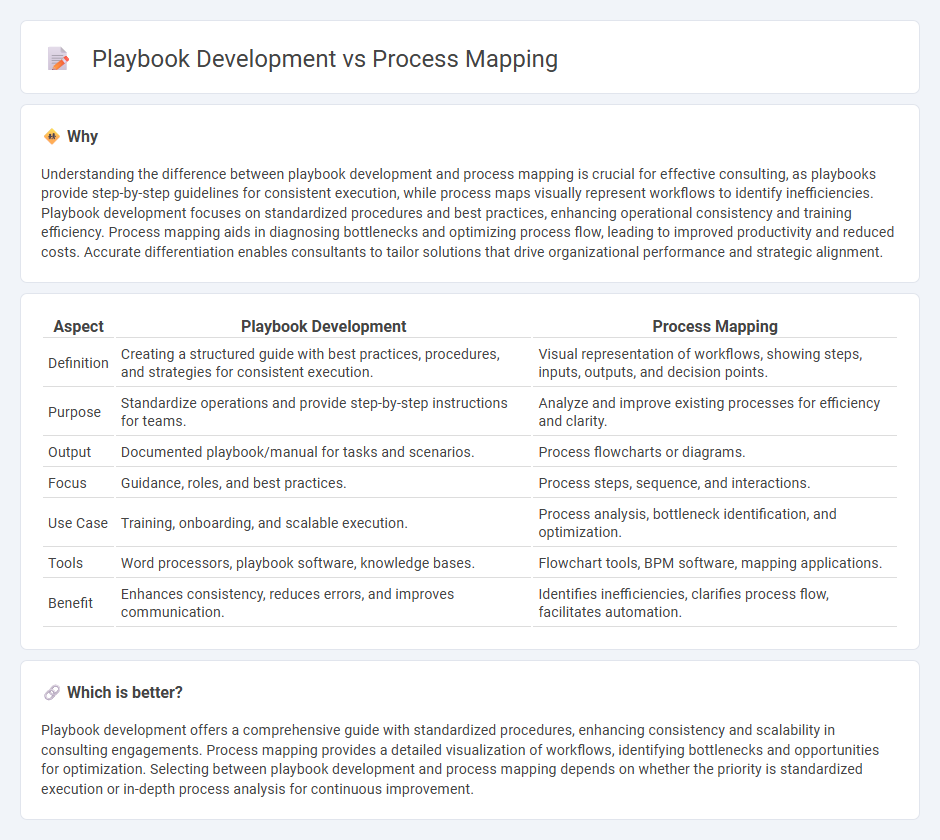
Playbook development consolidates best practices, guidelines, and standardized procedures into a single resource to ensure consistent execution across teams. Process mapping visually outlines workflows and sequences, identifying inefficiencies and areas for improvement within business operations. Explore the benefits of each approach to determine the best fit for your consulting needs.
Why it is important
Understanding the difference between playbook development and process mapping is crucial for effective consulting, as playbooks provide step-by-step guidelines for consistent execution, while process maps visually represent workflows to identify inefficiencies. Playbook development focuses on standardized procedures and best practices, enhancing operational consistency and training efficiency. Process mapping aids in diagnosing bottlenecks and optimizing process flow, leading to improved productivity and reduced costs. Accurate differentiation enables consultants to tailor solutions that drive organizational performance and strategic alignment.
Comparison Table
| Aspect | Playbook Development | Process Mapping |
|---|---|---|
| Definition | Creating a structured guide with best practices, procedures, and strategies for consistent execution. | Visual representation of workflows, showing steps, inputs, outputs, and decision points. |
| Purpose | Standardize operations and provide step-by-step instructions for teams. | Analyze and improve existing processes for efficiency and clarity. |
| Output | Documented playbook/manual for tasks and scenarios. | Process flowcharts or diagrams. |
| Focus | Guidance, roles, and best practices. | Process steps, sequence, and interactions. |
| Use Case | Training, onboarding, and scalable execution. | Process analysis, bottleneck identification, and optimization. |
| Tools | Word processors, playbook software, knowledge bases. | Flowchart tools, BPM software, mapping applications. |
| Benefit | Enhances consistency, reduces errors, and improves communication. | Identifies inefficiencies, clarifies process flow, facilitates automation. |
Which is better?
Playbook development offers a comprehensive guide with standardized procedures, enhancing consistency and scalability in consulting engagements. Process mapping provides a detailed visualization of workflows, identifying bottlenecks and opportunities for optimization. Selecting between playbook development and process mapping depends on whether the priority is standardized execution or in-depth process analysis for continuous improvement.
Connection
Playbook development and process mapping are interconnected through their focus on defining and standardizing business workflows to enhance operational efficiency. Process mapping visually captures the step-by-step activities within a process, providing a detailed blueprint that forms the foundation for creating comprehensive playbooks. Playbooks use these mapped processes to deliver actionable guidelines and best practices, ensuring consistent execution and facilitating training in consulting engagements.
Key Terms
Workflow Visualization
Workflow visualization in process mapping emphasizes detailed diagrams that illustrate each step, decision point, and process flow to identify inefficiencies and optimize operations. Playbook development focuses on creating structured guidelines and standardized procedures that ensure consistency and accountability across tasks. Discover how integrating these approaches can enhance operational clarity and performance.
Standard Operating Procedures (SOPs)
Process mapping visually outlines workflows to identify inefficiencies and standardize tasks, serving as a foundation for developing detailed Standard Operating Procedures (SOPs). Playbook development builds on process maps by creating comprehensive SOPs that include step-by-step instructions, roles, and responsibilities to ensure consistency and compliance across teams. Explore how integrating process mapping with playbook development can enhance operational efficiency and streamline SOP implementation.
Continuous Improvement
Process mapping visualizes workflows to identify inefficiencies and areas for improvement, serving as a foundational tool for Continuous Improvement initiatives. Playbook development codifies best practices and standard operating procedures to ensure consistent execution and scalability of optimized processes. Explore how integrating process mapping and playbook development can drive sustainable Continuous Improvement in your organization.
Source and External Links
Process Mapping - A process map graphically shows a process's inputs, actions, and outputs in a clear step-by-step manner to help understand, analyze, and improve the process by identifying strengths, weaknesses, and bottlenecks.
6 Simple Process Mapping Examples to Organize Your Work - Creating a process map involves identifying the process scope, involving key stakeholders, sequencing steps clearly with common symbols, and validating the workflow to optimize and continuously improve the process.
What is Process Mapping? | IBM - Process mapping visually represents workflows and task sequences using standard symbols, allowing organizations to communicate processes clearly, identify inefficiencies, and improve operational effectiveness.
 dowidth.com
dowidth.com